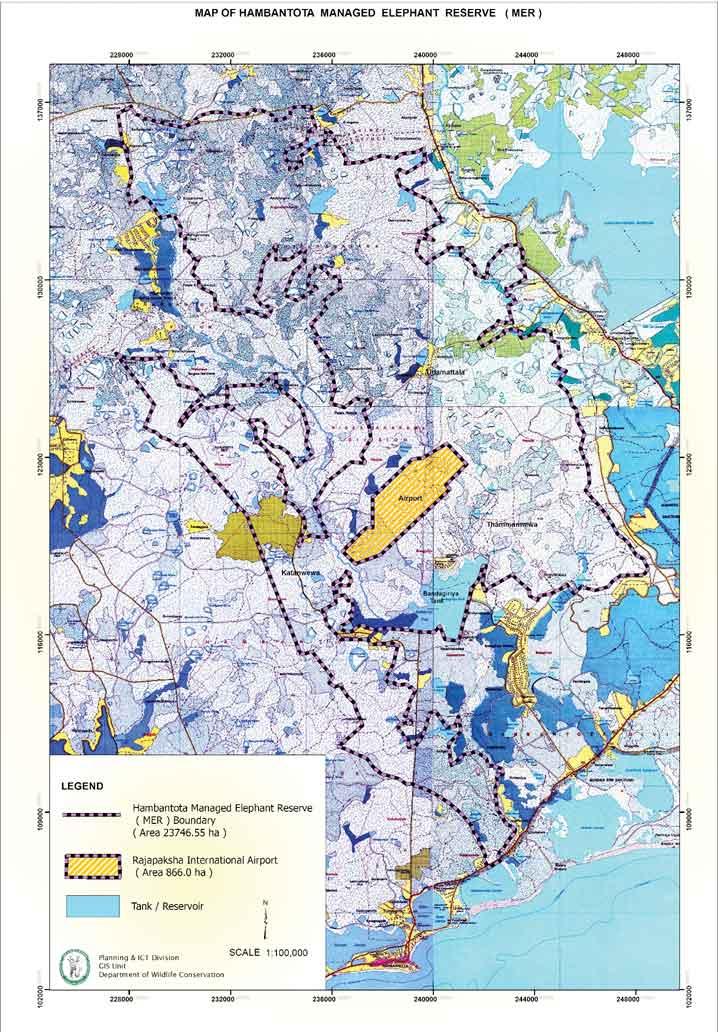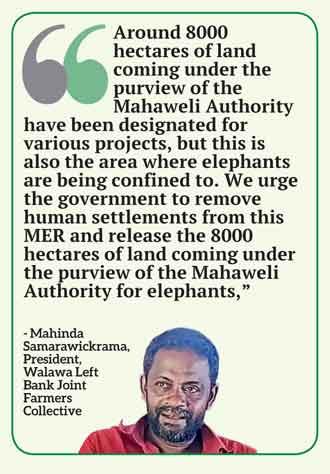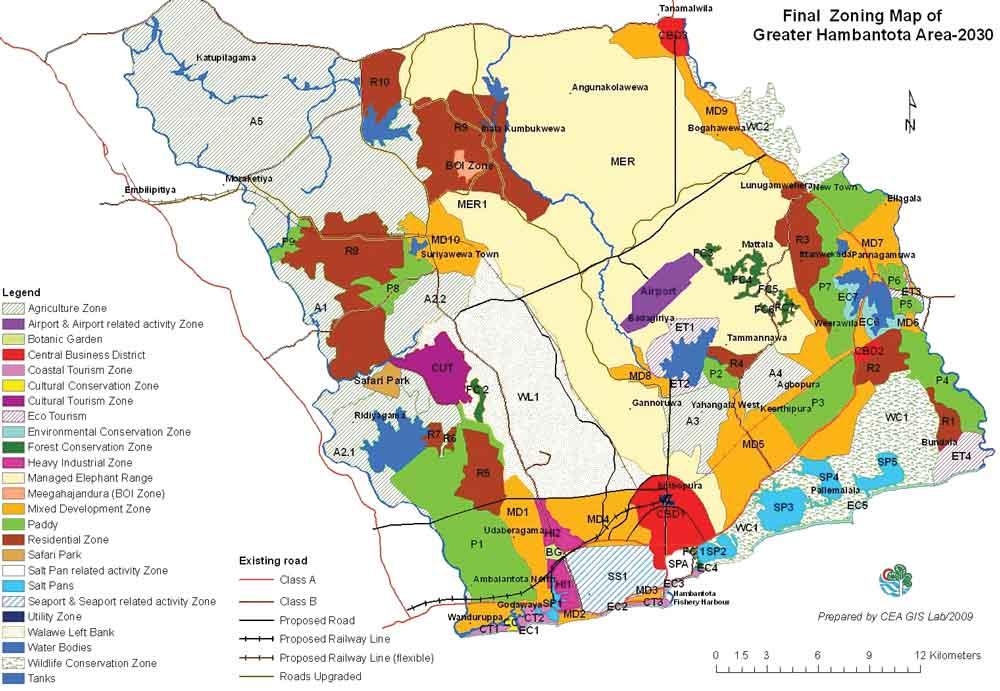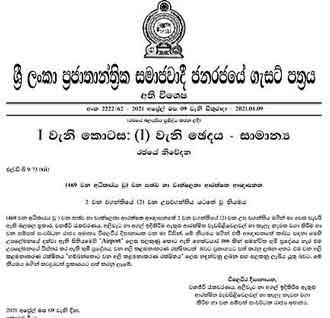Reply To:
Name - Reply Comment

Aftermath of the aggravating HEC - a house in Beragama damaged by an elephant
|
Repeated requests by farmers to provide a feasible solution to the aggravating HEC fell on deaf ears The MER in fact is an important elephant corridor that connected three main national parks including Bundala, Lunugamvehera and Uda Walawa The Proposed Managed Elephant Reserve came to light in 2012 and an electric fence was installed around this area
The gazette allocated 23,743.55 hectares of land for animals, but farmers claim that this gazette hasn’t been implemented to date The Mattala Airport had been constructed in an area that provided an abundance of water, food and shelter to elephants There are eight stone quarries in operation within the MER |
Farmers in Walsapugala staged a 108-day long protest back in 2021 braving various threats and challenges urging the then government to implement the Managed Elephant Reserve (MER) which allocated some 23,000 hectares to elephants that roam the area. The MER in fact is an important elephant corridor that connected three main national parks including Bundala, Lunugamvehera and Uda Walawa. Even though the MER has now been gazetted in response to the demands made by farmers, they continue to be at the receiving end of an aggravating Human-Elephant Conflict (HEC).

During a recent visit to Hambantota organized by the Centre for Environmental Justice (CEJ), this writer along with a team of journalists met with Mahinda Samarawickrama, President, Walawa Left Bank Joint Farmers Collective. It was Samarawickrama who led the protests back in 2021 where 86 farmer federations joined to support the cause. Speaking about the history of environmental destruction in Hambantota, Samarawickrama said that the Walawa Left Bank Irrigation Development Project was introduced in 1994. “Farming communities were settled in houses during the year 2000.
But the earliest inhabitants on this land were elephants and other wildlife. Post 2000, people started to experience a conflict with wildlife as the latter lost their habitats. Following our requests to the Mahaweli Authority and the then government, the Proposed Managed Elephant Reserve came to light in 2012 and an electric fence was installed around this area. In 2014 the authorities took measures to send all elephants to Lunugamvehera and Bundala National Parks. But this mission failed as there wasn’t enough space at the Lunugamvehera Park to accommodate all elephants. Thereafter, some of them were relocated within the MER. But due to various illegal activities that emerged within the MER, elephants continued losing their habitats and as a result they began raiding the surrounding villages, posing a threat to the lives of people,” said Samarawickrama.
An urgent plea from farmers
 Repeated requests by farmers to provide a feasible solution to the aggravating HEC fell on deaf ears and this prompted them to stage a protest that escalated to a fast unto death. “It’s not like we requested for lands,” continued Samarawickrama. “But the political authority refused our demands. Initially, 60,000 hectares were allocated for the MER. But local politicians claimed that they have earmarked various development activities within the MER including an Investment Development Zone and that they cannot allow animals within the area. We demanded that they allocate land for animals,” he added.
Repeated requests by farmers to provide a feasible solution to the aggravating HEC fell on deaf ears and this prompted them to stage a protest that escalated to a fast unto death. “It’s not like we requested for lands,” continued Samarawickrama. “But the political authority refused our demands. Initially, 60,000 hectares were allocated for the MER. But local politicians claimed that they have earmarked various development activities within the MER including an Investment Development Zone and that they cannot allow animals within the area. We demanded that they allocate land for animals,” he added.
In response, the then Wildlife Minister Wimalaweera Dissanayake issued a gazette in April 2021 which indicated the extent of land falling under the purview of the MER; excluding the Mattala Airport. The gazette allocated 23,743.55 hectares of land for animals, but farmers claim that this gazette hasn’t been implemented to date. “It has been drafted under the Flora and Fauna Protection Ordinance (FFPO) which allows various projects to be carried out within this area in addition to the presence of animals. As a result elephants are displaced from their habitats. As far as we know, a part of this Reserve is owned by the Mahaweli Authority, another part comes under the purview of the Forest Conservation Department, Divisional Secretary and so on. Around 8000 hectares of land coming under the purview of the Mahaweli Authority have been designated for various projects, but this is also the area where elephants are being confined to. The remaining areas within the gazette include villages. We therefore urge the government to remove human settlements from this MER and release the 8000 hectares of land coming under the purview of the Mahaweli Authority for elephants to live in,” Samarawickrama further said.

He further said that 2800 hectares have been allocated for paddy cultivation and another 3000 hectares to cultivate other crops. “We don’t oppose development, but just as humans are given their rights, animals too need to be granted their rights to live. The Mattala Airport had been constructed in an area that provided an abundance of water, food and shelter to elephants. Then they removed the signboard that indicated the Proposed MER and allocated 10-15 perch lands and set up human settlements. But none of these authorities conducted an assessment to determine the threat to the lives of people. As a result, many people are directly affected by the HEC. They light crackers, shout and do everything to make the animals even more excited and in turn they act in their defence. More elephants were displaced with the construction of the Hambantota Port and the botanical garden,” he added.
Samarawickrama further claimed that there are eight stone quarries in operation within the MER. “We don’t say that there shouldn’t be any quarries, but they need to be regulated. There are stone quarries every 2km apart. Elephants experience shock when two quarries carry out rock blasts simultaneously. Therefore we urge authorities to assess the impact on humans and elephants prior to allocating land for projects. People in these areas engage in their cultivation activities during the day and they keep awake at night to protect their lands. So there’s no rest for people. If destroyed, we have to wait for six months or one year to reap the next harvest. We don’t even receive compensation. It’s not that we hate elephants, but this has been a matter that had long been ignored by politicians,” he complained.
Fairy-tale promises
Following the protest the authorities responded to the people’s demands by promising to establish the electric fence, set up guard points every 2 kms to ensure that elephants don’t raid villages, according to Samarawickrama. “But these remained to be fairy tales and we didn’t receive any practical solutions. Our main demand is to protect the MER which acts as an elephant corridor. There also seems to be a lack of coordination among authorities. We incur a loss of around Rs. 35 lakhs if elephants destroy a banana cultivation, but when this was communicated to the DS she was of the view that none of the farmers earn such an amount in Mayurapura. It would cost Rs. 64,000 to grow 1000 banana trees. The government estimate for one coconut tree is Rs. 7500. But a kilo of coconuts is Rs. 140. If the trees are destroyed we have to wait five years till the next harvest. All these officials stay inside air conditioned rooms and calculate our losses. But they don’t pay any compensation. Farmers have the habit of storing paddy in their houses. But if an elephant damages a house, the officials would only take an estimate of the damage done to the property and not the paddy,” he added.
Aggravating HEC
Following the meeting with Samarawickrama, the Daily Mirror team left to Beragama because we were informed of a house that had been damaged by an elephant the previous night. A group of angry villagers greeted us as we walked towards the house which was partially damaged. The walls of a room had collapsed, creating a massive hole. There are terminally ill patients in some houses, children and those who are elderly. Collectively, all villagers are now vulnerable to threats from elephants. We were told that around five elephants roam the area daily. “There is no functioning electric fence around this village and however much we call the DWC they don’t arrive on time,” exclaimed one villager. “If they can’t resolve this problem then the government only has one option and that is to provide us with firearms. How can we live here when we know that our lives are at stake,” he questioned. The Daily Mirror learned that around six houses had been damaged within a span of a week.
Why the MER became a failure
 Including ‘Managed Elephant Reserves’ in the Greater Hambantota Development Plan for the first time in Sri Lanka was perceived as a landmark decision in the efforts to conserve wild elephant populations and mitigation of HEC. But researchers who have been studying on HEC claim that the MER was confined to signboards for many years. “Even though the gazette notification of the ‘Hambantota Managed Elephant Reserve’ was published in April 2021, as a result of the continuous farmers’ struggle, we are still far from achieving the desired goals,” said Conservationist and Researcher Supun Lahiru Prakash.
Including ‘Managed Elephant Reserves’ in the Greater Hambantota Development Plan for the first time in Sri Lanka was perceived as a landmark decision in the efforts to conserve wild elephant populations and mitigation of HEC. But researchers who have been studying on HEC claim that the MER was confined to signboards for many years. “Even though the gazette notification of the ‘Hambantota Managed Elephant Reserve’ was published in April 2021, as a result of the continuous farmers’ struggle, we are still far from achieving the desired goals,” said Conservationist and Researcher Supun Lahiru Prakash.
He explained that the concept of Managed Elephant Reserves was introduced to protect the elephant home range outside the protected areas because after over 60 years of attempting to restrict elephants to protected areas. “But even today 70% of the elephant range lies within an area where people also reside. HEC occurs entirely outside protected areas. In areas such as Polonnaruwa, Puttalam and Hambantota, electric fencing of protected area boundaries has been completed, but HEC continues to be a major issue. The failure to limit elephants to protected areas, despite an immense effort by the Department of Wildlife Conservation (DWC) over many decades, sometimes at the cost of the life of DWC officers, is due to some biological and ecological reasons including elephant behaviour, and issues with carrying capacity,” he added.
 The National Action Plan for the Mitigation of Human-Elephant Conflict (December 2020) in Sri Lanka also emphasises the importance of identifying and delineating elephant-ranging areas consisting of Elephant Conservation Areas, Managed Elephant Reserves, and forest connectivity (corridors) to ensure the free movement of elephants.
The National Action Plan for the Mitigation of Human-Elephant Conflict (December 2020) in Sri Lanka also emphasises the importance of identifying and delineating elephant-ranging areas consisting of Elephant Conservation Areas, Managed Elephant Reserves, and forest connectivity (corridors) to ensure the free movement of elephants.
Prakash said that the main reason for the ‘Hambantota Managed Elephant Reserve’ to become a failure was because the gazette did not include any regulations related to the administration of this piece of land and still no one knows who is responsible for the administration of this land. “On the other hand, no action was taken to stop human activities from taking place inside the Hambantota Managed Elephant Reserve; activities which were harmful to elephants such as unauthorized cultivations, soil excavations and granite mining. Nothing was done to either make this land favourable for elephants or stop land grabbing and the encroachment of elephants’ home range. Under these circumstances, elephant attacks will be further escalated in a large number of villages located around MER including Mahagalwewa, Unathuwewa, Kudaindiwewa, Thaligama, Dimutugama, Padavgama, Gonnoruwa, Hadilla, Udamathala, Pahalamathala and Punchiappujandura,” added Prakash.
He further suggested several immediate actions that the newly appointed government could take if there is any intention to resolve this issue and provide a favorable environment for both farmers and elephants to coexist.
These include:
Enacting regulations to administrate the MER
Removing all the encroachers, stopping anthropogenic activities harmful to elephants inside MER, and acquiring all lands mapped in the gazette
Conducting a survey and map and linking the existing forested lands outside the MER and the gazetted MER
Removing all the electric fences set up as administrative boundaries between the forested lands belonging to different government and private parties (this action will ensure the free movement of elephants till the lands are used for development activities. When the development happens elephants will gradually go away from these areas. Till then they can roam around in these lands and HEC will be controlled)
Conducting habitat enrichment activities to convert degraded lands to be favorable for elephants
Awaiting response from AG’s Department: Sooriyabandara
 Speaking to the Daily Mirror, DWC Director General M. G. C Sooriyabandara said that the regulations of the MER have already been submitted to the Attorney General’s Department. “The Attorney General had requested us to submit our comments and he is looking into our submissions in detail. Once the AG submits his recommendations we can see how to implement these regulations in full,” said Sooriyabandara.
Speaking to the Daily Mirror, DWC Director General M. G. C Sooriyabandara said that the regulations of the MER have already been submitted to the Attorney General’s Department. “The Attorney General had requested us to submit our comments and he is looking into our submissions in detail. Once the AG submits his recommendations we can see how to implement these regulations in full,” said Sooriyabandara.
When asked about illegal projects taking place within the MER, Sooriyabandara said that certain land management companies can act within existing regulations which fall under the purview of the FFPO.
Several attempts to contact Hambantota Divisional Secretary Mrs. G. C. R Wijewardhana and Mahaweli Development Authority Director General Mahendra Abeywardena to inquire about the procedures to be followed when allowing private projects to be carried out within the MER proved futile.